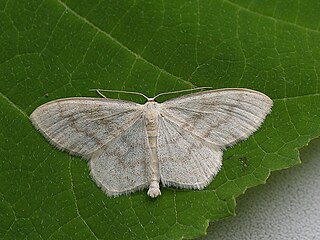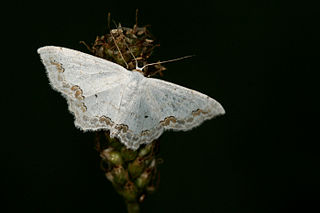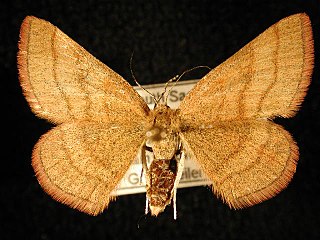
The geometer moths are moths belonging to the family Geometridae of the insect order Lepidoptera, the moths and butterflies. Their scientific name derives from the Ancient Greek geo γεω, and metron μέτρον "measure" in reference to the way their larvae, or inchworms, appear to measure the earth as they move along in a looping fashion. A very large family, it has around 23,000 species of moths described, and over 1400 species from six subfamilies indigenous to North America alone. A well-known member is the peppered moth, Biston betularia, which has been subject of numerous studies in population genetics. Several other geometer moths are notorious pests.

The cream wave is a moth of the family Geometridae. The species was first described by Adrian Hardy Haworth in 1809. It is found in forest and woodland regions, feeding on grasses and small plants such as dandelion.

Scopula decorata, the middle lace border, is a moth of the family Geometridae. It is found throughout Europe.

Scopula immorata, the Lewes wave, is a moth of the family Geometridae. It is found throughout Europe and the Near East.

Scopula immutata, the lesser cream wave, is a moth of the family Geometridae. It was described by Carl Linnaeus in his 1758 10th edition of Systema Naturae. It is found throughout Europe.

Scopula marginepunctata, the mullein wave, is a moth of the family Geometridae. It was described by Johann August Ephraim Goeze in 1781. It is found throughout Europe.

Scopula rubiginata, the tawny wave, is a moth of the family Geometridae. The species was first described by Johann Siegfried Hufnagel in 1767.

Scopula ornata, the lace border, is a moth of the family Geometridae. The species was first described by Giovanni Antonio Scopoli in his 1763 Entomologia Carniolica. It is found in Europe, North Africa and the Near East.

Scopula limboundata, the large lace-border, is a moth of the family Geometridae. It was described by Adrian Hardy Haworth in 1809. It is found in North America east of the Rocky Mountains. There is a single and unconfirmed record from Great Britain.

Scopula junctaria, the simple wave, is a moth of the family Geometridae. The species was first described by Francis Walker in 1861. It is found in the whole of Canada and the northern United States, south to Maryland, Arizona, and California.

Scopula frigidaria is a moth of the family Geometridae. It was described by Heinrich Benno Möschler in 1869. It is found from Fennoscandia to the Kamchatka Peninsula and in northern North America, where it occurs across the boreal forest region, from Alaska across the Northwest Territories and Nunavut to Newfoundland, and in the mountains south to southern Wisconsin, Alberta and British Columbia.

Scopula incanata is a moth of the family Geometridae. It is found from north-eastern Europe and the Caucasus to southern Siberia and northern Mongolia.

Scopula virgulata, the streaked wave, is a moth of the family Geometridae. The species was first described by Denis & Ignaz Schiffermüller in 1775. It is found from most of Europe to central Asia and northern Mongolia.

Scopula minorata is a moth of the family Geometridae. It was described by Jean Baptiste Boisduval in 1833. It is found in Africa south of the Sahara, the Arabian Peninsula and on the islands of the Indian Ocean. Furthermore, it is found in southern Europe. It can be distinguished from Scopula lactaria only by examination of its genitalia.

Scopula emutaria, the rosy wave, is a species of moth in the family Geometridae. It is found in western and south-western Europe and Romania. Also in North Africa.
Scopula confinaria is a moth of the family Geometridae. It is found in southern Europe, southern Russia and Turkey.

Scopula nemoraria is a moth of the family Geometridae. It is found from central to eastern Europe, east to Russia and China.

Scopula submutata, the Mediterranean lace border, is a moth of the family Geometridae. It is found in southern Europe, North Africa and the Near East. The habitat consists of open, dry grassland and rocky slopes.

Scopula sentinaria is a moth of the family Geometridae. It is found from Alaska to Labrador, south in the prairies to southern Manitoba, Saskatchewan, Alberta and British Columbia. In the mountains it ranges south to Colorado. The species is also found in northern Russia and the Sayan Mountains. The habitat consists of dry shrubby clearings and edges.

Scopula umbelaria is a moth of the family Geometridae described by Jacob Hübner in 1813. It is found in the Benelux, France, Italy, Germany, Switzerland, Austria, the Czech Republic, Slovakia, Hungary, Slovenia, former Yugoslavia, Romania, Poland and Russia. In the east, the range extends to the eastern part of the Palearctic realm.



















